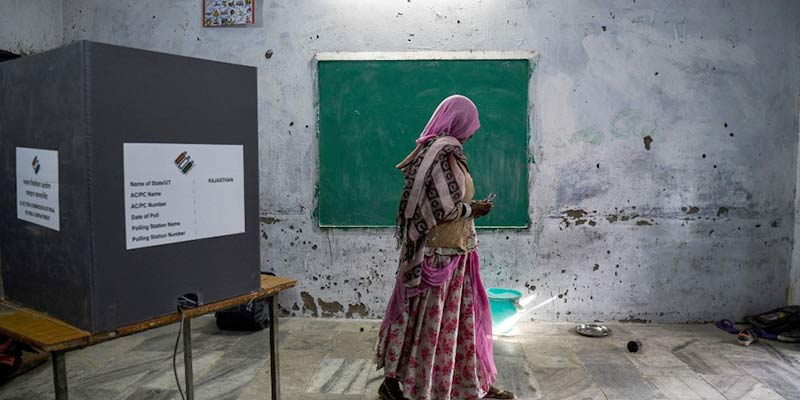- India
- Jun 20
PM pitches for one nation, one election
The Narendra Modi government has decided to constitute a committee to prepare a road map for ‘one nation, one election’. The decision was taken after a meeting attended by presidents of 21 parties on June 19. However, 11 political parties, including the Congress, skipped the meeting convened by the PM.
Simultaneous elections refer to holding elections to the Lok Sabha, state Legislative Assemblies, panchayats and urban local bodies simultaneously once every five years.
Background
* The Election Commission had advocated as early as 1983 that a system should emerge so that elections to the Lok Sabha and state Assemblies could be held simultaneously.
* In May 1999, the Law Commission headed by Justice B.P. Jeevan Reddy had said that “we must go back to the situation where elections to the Lok Sabha and Legislative Assemblies were held at once”.
* Official discussions among lawmakers commenced much later. In its December 2015 report on Feasibility of Holding Simultaneous Elections to the House of People and State Legislative Assemblies, the Parliamentary Standing Committee on Personnel, Public Grievances, Law and Justice supported “an alternative and practicable method of holding simultaneous elections, which involves holding of elections in two phases” - halfway into the term of the current Lok Sabha (November 2016 for some Assemblies) and at the end (June 2019) for the rest.
* The committee recommended that “elections to all state Assemblies whose terms end prior to or after a time period of six months to one year from the appointed election date can be clubbed together”.
* It proposed that terms of current Assemblies be curtailed or extended to align with the new simultaneous election cycle.
Arguments in favour of simultaneous polls
A report of the parliamentary committee on the Feasibility of Holding Simultaneous Elections to the House of People (Lok Sabha) and State Legislative Assemblies says that the holding of simultaneous elections to the Lok Sabha and state Assemblies would reduce...
* The massive expenditure that is currently incurred for the conduct of separate elections;
* The policy paralysis that results from the imposition of the Model Code of Conduct during election time;
* Impact on delivery of essential services;
* Burden on crucial manpower that is deployed during election time;
* The disruption to normal public life associated with elections, such as increased traffic and noise pollution.
The EC’s view
* While the EC has reiterated its support for holding simultaneous polls, provided the legal and financial challenges are overcome, it is also learnt to have alternatively suggested that all the elections due in a year may be held together.
* Currently, the EC conducts elections together for states where the term of Assemblies end within a few months of each other. This is because Section 15 of the Representation of the People Act, 1951, prohibits the EC from notifying elections more than six months before the term of a state Assembly is about to expire.
* According to experts, accomplishing ‘one year one election’ will be easier as it doesn’t require as many legal amendments as simultaneous polls for which the Centre will have to make five amendments to the Constitution.
According to the EC, Articles in the Constitution that are to be tweaked are…
* Article 83, which deals with the duration of Houses of Parliament need an amendment
* Article 85 (on dissolution of Lok Sabha by the president)
* Article 172 (relating to the duration of state legislatures)
* Article 174 (relating to dissolution of state assemblies)
* Article 356 (on President’s rule)
The Representation of the People Act, 1951, would have to be amended to build in provisions for stability of tenure for both parliament and assemblies. This should include the following crucial elements…
* Restructuring the powers and functions of the EC to facilitate procedures required for simultaneous elections
* A definition of simultaneous election can be added to Section 2 of the 1951 Act.
Consequences of aligning elections
* Political incentives for aligning elections is to increase the extent to which national politics dominates state-level electoral contests, or in other words to centralise political life.
* It would attempt to reverse the trend of the past several decades in which state politics has been the pre-eminent arena of Indian politics. Evidence from other countries suggests that simultaneous elections do indeed have a nationalising effect on political competition.
* The trend of choosing the same party at the state and the Centre has gone from 68 per cent in 1999 to 77 per cent in 2004 to 76 per cent in 2009 and 86 per cent in 2014.
International scenario
Data from countries such as Brazil, Argentina, Canada, Germany and the US supports the idea that elections that are held simultaneously produce greater alignment between the national and regional election outcomes.
Conclusion
* If all elections in a year are clubbed together, the terms of state Assemblies, which are expiring later in the year, need not be curtailed. They can complete their term that year and the new government can be sworn in after that.
* No doubt, conducting concurrent elections is an immense logistical task in terms of deployment of personnel, EVMs and other material. But the time has come to make a beginning and ensure political and administrative stability both at the Central and state levels for the country to march unhindered on the path to progress.
* Once a political consensus is built on the issue, constitutional amendments could be put in place for a fixed tenure of the legislative bodies and the process kick-started.
* Unlike ‘one nation one election’, which prioritises economic costs of elections over the exercise itself, it will avoid clubbing of national and state issues, it will not disturb federalism much, not much issues generated by emergencies like need to hold by-election etc will be addressed by this option.

